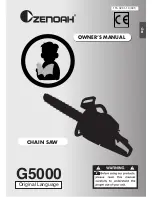
12
EN
G
LI
SH
2
1
2
3
1
C
D
F
E
2
1
2
3
1
2
1
2
3
1
3–5 cm
3/4
1/4
1. Normal tree felling consists of two cutting phases,
the notching undercut (C) and the felling back cut (D).
2. Start with the upper notching cut (C) on the side of
the tree facing the direction of fall (E). Then make
the lower, horizontal notching cut so that it meets
the upper notching cut (do not cut too far).
3. The notching undercut should be wide enough to
steer the tree during as much of the fall as possible.
Warning: Never walk in front of a tree in which you
have made a notching undercut.
4. Make the felling back cut (D) from the other side
of the tree, parallel to but 3–5 cm higher than
the horizontal notching cut.
Warning:
Before making the final cut, check again that there are no
onlookers, pets or other obstacles in the vicinity.
Use a felling wedge of plastic or wood to prevent the guide bar
from being clamped down upon in the cut.
Note:
If the diameter of the tree is larger than the length of the guide bar you must make two cuts.
Warning:
When the felling cut (D) has been made so deep that only the hinge (F) is left, the tree can begin to fall, otherwise
you must use a felling wedge or crowbar to help.
When the tree begins to fall, remove the chainsaw from the cut and switch off the motor. Retreat diagonally backwards and to
the side along your planned escape route and keep your eye on the tree while it is falling.
De-limbing/Snedding
NEVER cut completely through the remaining trunk. ALWAYS leave a hinge (F). It is the hinge that steers the tree during the fall.
The hinge wood keeps the tree from twisting and falling in the wrong direction. Do not cut through the hinge. As the saw
chain gets close to the hinge, a felling wedge should be inserted into the felling back cut. If the entire felling cut is made before
a felling wedge has been placed in the saw cut, there is a risk of the tree rocking backwards and pinching the saw chain. Before
felling the tree by driving in the felling wedge, make sure that there are no bystanders or pets in the fall area.
De-limbing (or snedding) means cutting away
the branches and shoots of a fallen tree. Start by cutting
the higher branches on the tree. Stand to one side
of the tree and de-limb them from the other side of
the trunk/stem (the trunk will serve as protection between
you and the chainsaw). Use caution when cutting
branches which are under tension. They must be cut from
the correct side; otherwise the guide bar will get stuck.
Warning:
Never stand on the stem of a tree while
de-limbing (snedding) it.













































